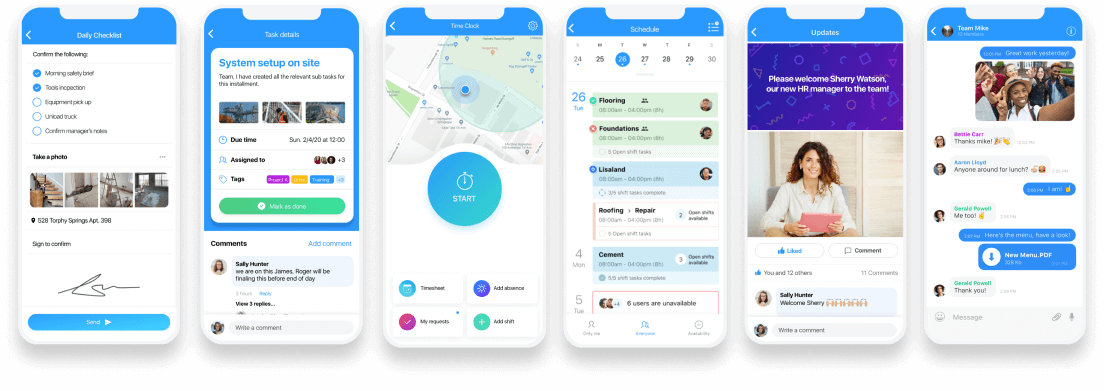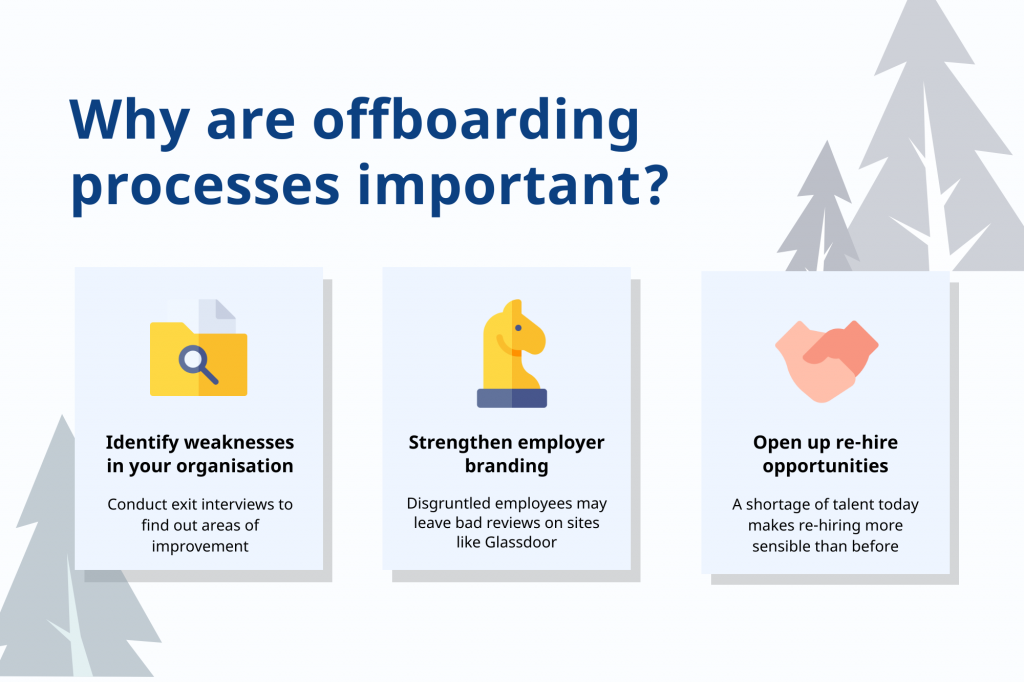Whether you are an HR Manager or a business owner, creating a smooth offboarding process for your company is a must. This blog explains exactly what offboarding is, why it matters and the tools one can use to make an employee’s departure as easy as possible.
Table of contents
If you’re reading this, you have probably already been employed at least a handful of times.
I know I have, with varying levels of success.
Truth be told, not all of those jobs ended on the best of terms. On the one hand, I might not have given the company enough reasons to keep me around. On the other hand, maybe the company didn’t do enough to leave the door open for my return.
Either way, many of you will probably agree that those last few weeks of work could have run a bit smoother.
And now, employee turnover is at an alarming high.
According to the Bureau of Labor Statistics, the average job tenure has declined to 4.1 years.
While a number of factors have played a part in this, including the pandemic and generally poor employee engagement, the nature in which an employee departs a company is often overlooked.
Ultimately, there are two kinds of company alumni: those who are friends of the company and those who became enemies.
For every person who ends their job on bad terms, there are countless potential candidates who may be put off. The last thing any company wants is negative reviews posted online from former employees. This can give your company a bad name and less people are going to even want to apply for open positions.
- A study conducted by Software Advice revealed that more than 50% of job seekers checked out job reviews on Glassdoor prior to submitting their resumes.
- Not to mention the fact that this was the first thing that nearly half of those people did during the job hunting process.
- Just like poor restaurants and tourist attractions on TripAdvisor – who’s going to want to apply for a company that only has a one star rating?
Those last few days/weeks on the job can determine how many outgoing employees become either friends or foes. In order to secure more of the former, it is imperative for HR and management to put time and care into creating an efficient offboarding experience for their employees.
We are going to give you a clear definition of this unusual term, as well as its importance to all companies and the benefits that a well-tuned offboarding program brings to the company. We will also show you some useful tools and software that companies can use to make offboarding a much smoother experience, both for the employer and employee.
What Exactly Is Offboarding?
There are numerous ways that you could end your current employment. You could hand in your letter of resignation, your employment could be formally terminated, or you may be of a certain age where you are ready to retire.
Whatever the case may be, you are going to undergo some kind of offboarding.
The definition of offboarding is pretty simple, when you think about it. If onboarding is the process where new employees acquire relevant skills, knowledge and resources, then offboarding is the fundamental opposite of this – putting it back into the company before you leave.

Offboarding is basically the formal separation between the employee and the company.
Some typical offboarding processes include:
- Returning equipment
- Receiving an exit interview
- Forfeiting access rights such as keys, passwords, etc.
- Handing over job responsibilities
Offboarding is supposed to help both parties tie up loose ends before parting ways.
Both the manager and the employee could receive valuable feedback from each other, learning how to improve working conditions between future management and employees. But is it really worth the time and effort?
Digitize and Streamline Your Offboarding Process With Connecteam Today!
Benefits of a Proper Offboarding Process
There are a handful of standout benefits that come from implementing an efficient offboarding process for outgoing employees. One might assume that it is the employee who benefits primarily from it. This is the main reason why companies overlook it so much. As a manager, you might be asking yourself, “If someone is leaving us, why bother giving them a formal departure? What’s the point?” But the reality is that a proper offboarding process creates a domino effect of benefits for all parties involved.
- The company’s reputation – A quality offboarding may help improve the employee’s last impressions of the company they’re leaving. It can also facilitate better reviews, word-of-mouth, and may even lead to more employee referrals.
- Data security – It is crucial that outgoing employees are removed from all online company accounts, in order to ensure that they are not tampered with post-employment. A quality offboarding program will leave no stone unturned when it comes to data security.
- Maintaining a positive company culture – Negativity can spread through a company like wildfire, and it can come from the unlikeliest of sources, such as someone’s offboarding. If employees see that someone is suffering on their way out of a job, that can cause more bad energy and an increase in employee turnover.
- Creating “boomerang employees” – One small thing that a lot of companies fail to do is leave the door open for employees to return in the future. Leaving things on good terms can create boomerang employees. Spherion and Research Now conducted a survey among over 1,000 workers, revealing that nearly 30% had returned to a previous employer. An additional 41% admitted that they were open to “boomeranging.”
Make Offboarding Painless With These Tips and Tools
All-in-one company apps are becoming an increasingly popular solution in making the employee experience more engaging than ever before. Why bother with an exhaustive range of communication options when you can conduct all of your company affairs in one place?
This helps in virtually every stage of the employee lifecycle – including onboarding, performance management, and offboarding.
Connecteam is a tool that managers can use to make the offboarding process smooth. The following tips and tools show how Connecteam can improve the process for departing employees:
- Managers can create surveys that offboarding employees can use to answer questions about their experience at the company. This can provide important information that could help the company improve management of future employees. The suggestion box is also a useful feature that allows employees to submit productive feedback that could make a huge difference in the long term.
- Create a checklist for your offboarding employees. Or provide them with all of their last minute tasks they need to complete before moving onto their next venture. Whether they need to return uniforms/equipment or transfer important skills and responsibilities to new staff members, they will know every loose end they need to tie up, all on one app.
- The closing weeks of an employee’s tenure can be unnecessarily stressful. With the employee scheduler, managers can ensure that offboarding employees are aware of all upcoming events they are expected to attend. These can include anything from exit interviews to handover sessions, and even farewell parties.
- Managers can improve the company’s data security by deleting or archiving users. While both of these features remove the user from the app, “archiving” ensures that former employees are not able to get company data. This means that important information, files, communication and knowledge are protected at all times. However, as the manager, you still have access to all of the employees’ information, including their old timesheets.
- The app’s social feed can be used to digitally inform the company about an employee’s imminent departure. This allows coworkers to send farewell messages via videos, photos and GIFs, ensuring that employees feel recognized for their hard work prior to their departure.
All of the aforementioned features are must-haves when it comes to creating an efficient offboarding program and as you can see – Connecteam has all of these things, and more.
The Bottom Line on Offboarding
In order to fully reap the awards of offboarding, you need to look at your company’s current offboarding process and give an honest assessment of its success.
- Is the employee receiving all of the necessary steps to tie up all loose ends?
- What does the company culture look like after each departure. Does it change? If so, does it improve or get worse?
- Are the company reviews on Glassdoor becoming more favorable?
- Does the company need to chase up alumni about the outstanding steps that weren’t already completed?
All of these questions will help.
As previously mentioned, there are a variety of tools that you can implement in order to make offboarding smooth and seamless. Providing detailed checklists and relevant tasks will ensure that all necessary offboarding steps are taken by the employee. Giving the departer a chance to provide feedback and suggestions can help improve the company in all kinds of ways. Scheduling exit interviews is obviously essential and of course, you can improve data security by archiving a user on your all-in-one app.
Feel free to refer back to everything we have touched upon in this blog in order to be fully clued up on what successful offboarding truly looks like. Because if there’s anything you should take away from this, it is that a company’s last impressions are just as important as the first ones.
Make Onboarding and Offboarding Smoother With Connecteam!
14-Day Free Trial, No Credit Card Required.


